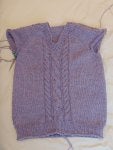Typically when working with wool, my preferred method to join yarn is a spit splice. I didn't do a good job so the joined yarn is too thick It's a glaring eyesore in my sweater. Perhaps you can see it just to the right at the end of the raglan increase of the right sleeve. I've tried to minimize the appearance but am not pleased. What would you recommend?

How to fix bad spit splice
1 - 20 of 40 Posts
Joined
·
273 Posts
Typically when working with wool, my preferred method to join yarn is a spit splice. I didn't do a good job so the joined yarn is too thick It's a glaring eyesore in my sweater. Perhaps you can see it just to the right at the end of the raglan increase of the right sleeve. I've tried to minimize the appearance but am not pleased. What would you recommend?
Attachments
-
120.9 KB Views: 45
Joined
·
1,209 Posts
forgetaboutit!
Joined
·
8,194 Posts
Well I don't see it. I like the Braided Join...
Joined
·
273 Posts
Lol!! That is an option.agioblas said:forgetaboutit!
Joined
·
30,627 Posts
When worn, the arm will probably cover that nicely. I say leave it. Very nice sweater.
Joined
·
273 Posts
Thank you.
Joined
·
23,765 Posts
I can't see it either. I suppose if it really, really bothers you you could fix it somehow. I agree it's not anything to worry about.
Joined
·
19,300 Posts
Location:
Kernersville, NC, USA
It would bother me too on such a lovely knit. Can you tease it apart and work the ends in? I don't use a spit join because I like long ends to work in. It may look much better after blocking.
Joined
·
7,396 Posts
It's just to the right and slightly above the blue stitch marker, on the body of the sweater, right?
Try using a small crochet hook to pull the bump to the inside.
Try using a small crochet hook to pull the bump to the inside.
I think when it's washed and while you're blocking it, you can work it lightly with your fingers and get it to not be noticeable. When I join yarns I loop the end of the working yarn close to the end for 3 or 4 stitches then loop the new yarn in and do a few stitches, leave tails to weave in later, so, that whole area is double yarn and when it's all done it barely shows. I am pretty sure yours will put it's self in a better position once you're done with it. I sure hope so, now that I've told you it should. The only other ting you could do is take it all out and fix the area, don't think you want to do that, by fix I mean change the placing of the join. I want to know what you decide to do and see it when you're done.
Joined
·
49,528 Posts
I would leave it...think it will look better when blocked and worn!
Joined
·
2,028 Posts
Since it really bothers you, you could try using a duplicate stitch embroidery to replace the bumpy area. I suggest cutting the yarn at the splice, unraveling the original stitches for 2”, splice in approximately 12” length of yarn and then follow the original yarn path until you reach an area near the arm where you can hide the ends.
Joined
·
2,028 Posts
Since it really bothers you, you could try using a duplicate stitch embroidery to replace the bumpy area. I suggest cutting the yarn at the splice, unraveling the original stitches for 2”, splice in approximately 12” length of yarn and then follow the original yarn path until you reach an area near the arm where you can hide the ends.
Joined
·
8,113 Posts
Location:
ON, Canada & FL, US
The sweater is really lovely. I see what you mean about the spit splice, and I think that would bother me too. The trick would be to find a solution that will look better, and I'm not sure about that. You could put a lifeline in the row above and the row below, cut the middle stitch, remove those stitches you don't like, and graft (Kitchener stitch) them back together with a fresh piece of yarn. If you do an outstanding job, you may like the look better. If not, it still might bother you. Be careful not to go so far as to involve the raglan stitches themselves.
All things considered, Only you can decide if it will be a worthwhile effort. Before deciding, take a tapestry needle or a thin knitting needle and carefully and gently see if you can adjust / tease some of the looseness of those stitches away from where it is and spread the looseness across that row. That might just be enough to even everything out.
This video, although it won't help you with this fix, may help with future spit splices. It's very short and by Suzanne Bryan. She has managed to simplify it, and when I spit splice, it's the way I do it. Good luck, and let us know how it goes.
All things considered, Only you can decide if it will be a worthwhile effort. Before deciding, take a tapestry needle or a thin knitting needle and carefully and gently see if you can adjust / tease some of the looseness of those stitches away from where it is and spread the looseness across that row. That might just be enough to even everything out.
This video, although it won't help you with this fix, may help with future spit splices. It's very short and by Suzanne Bryan. She has managed to simplify it, and when I spit splice, it's the way I do it. Good luck, and let us know how it goes.
Joined
·
23,765 Posts
targa416 said:The sweater is really lovely. I see what you mean about the spit splice, and I think that would bother me too. The trick would be to find a solution that will look better, and I'm not sure about that. You could put a lifeline in the row above and the row below, cut the middle stitch, remove those stitches you don't like, and graft (Kitchener stitch) them back together with a fresh piece of yarn. If you do an outstanding job, you may like the look better. If not, it still might bother you. Be careful not to go so far as to involve the raglan stitches themselves.
All things considered, Only you can decide if it will be a worthwhile effort. Before deciding, take a tapestry needle or a thin knitting needle and carefully and gently see if you can adjust / tease some of the looseness of those stitches away from where it is and spread the looseness across that row. That might just be enough to even everything out.
This video, although it won't help you with this fix, may help with future spit splices. It's very short and by Suzanne Bryan. She has managed to simplify it, and when I spit splice, it's the way I do it. Good luck, and let us know how it goes.
I felt really good when I saw that video because I had already figured it out. How many of us can claim thinning out some plies for spit splicing our unvention? I was quite sure I wasn't the first to do it.
Joined
·
2,112 Posts
I had a sweater that I had knitted a while before and it had a moth hole in it. I took it to a great knitting store and there was an expert there who was able to repair it perfectly. I had to supply a little more of the yarn. She was able to remove a few stitches on either side of the problem area and repair it invisibly.
I have to say that I am too nervous about things coming apart to use a split splice.
If I don't add a new yarn at a seam (at edge of work--which I prefer), I usually knit about three stitches together with both yarns.
It's also possible to knit just one stitch together with both yarns or even zero stitches together with both yarns. Just start a new yarn and leave both ends dangling.
Very Pink has a great video about how to weave in the end on a reverse stockinette side:
https://verypink.com/2019/05/29/slow-motion-weaving-ends/
It helps to have a large blunt needle with a bent end.
I have to say that I am too nervous about things coming apart to use a split splice.
If I don't add a new yarn at a seam (at edge of work--which I prefer), I usually knit about three stitches together with both yarns.
It's also possible to knit just one stitch together with both yarns or even zero stitches together with both yarns. Just start a new yarn and leave both ends dangling.
Very Pink has a great video about how to weave in the end on a reverse stockinette side:
https://verypink.com/2019/05/29/slow-motion-weaving-ends/
It helps to have a large blunt needle with a bent end.
Joined
·
17,603 Posts
Location:
Sydney NSW Australia
I would just block that area now to see if that makes a difference.
Joined
·
23,353 Posts
In future, use a different join. Russian Join would be a better choice, IMHO. I sometimes, just weave in end of new yarn while working ith old yarn for 6 or so stitches, then work new yarn while weaving old yarn...leave some tails, so you can weave them in opposite direction on next row/round.LindseyR said:Typically when working with wool, my preferred method to join yarn is a spit splice. I didn't do a good job so the joined yarn is too thick It's a glaring eyesore in my sweater. Perhaps you can see it just to the right at the end of the raglan increase of the right sleeve. I've tried to minimize the appearance but am not pleased. What would you recommend?
Joined
·
4,216 Posts
Until I read where to look I had not noticed. I'm sure when it is worn it will not be noticed and may even disappear when washed.
The sweater is beautiful, the color and cables are what will be seen first. It was for me.
The sweater is beautiful, the color and cables are what will be seen first. It was for me.
Joined
·
1,437 Posts
I'd recommend (tongue-in-cheek) not looking so closely.
1 - 20 of 40 Posts
-
?
-
?
-
?
-
?
-
?
-
?
-
?
-
?
-
?
-
?
-
?
-
?
-
?
-
?
-
?
-
?
-
?
-
?
-
?
-
?
- posts
- 17M
- members
- 247K
- Since
- 2011
A forum community dedicated to all levels of knitters and enthusiasts. Come join the discussion about collections, displays, how-tos, patterns, tutorials, styles, scales, reviews, swaps, accessories, classifieds, and more!




